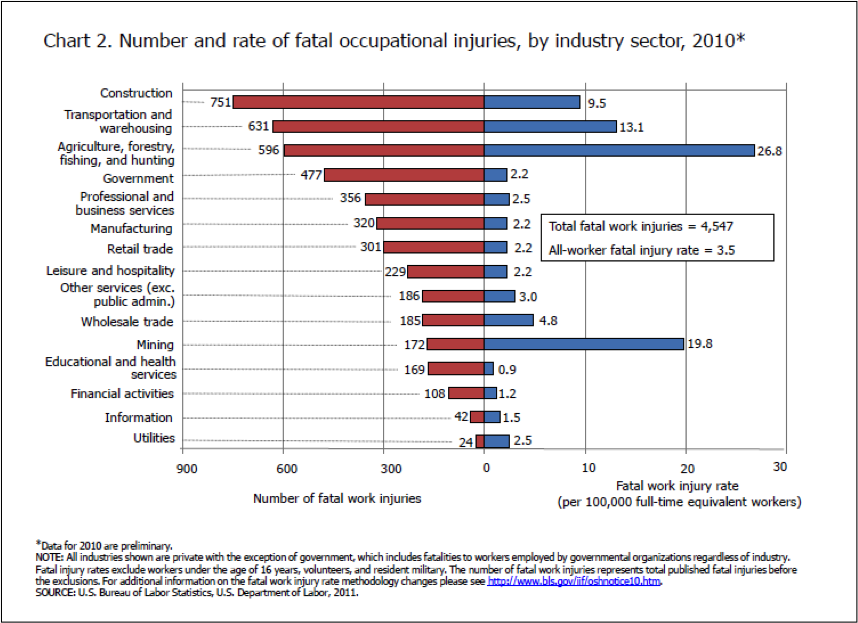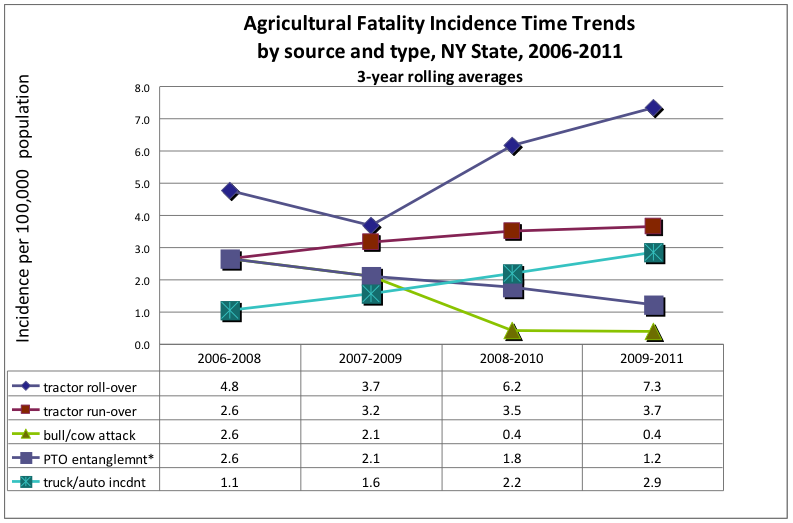Tractor and machinery hazards
Introduction – epidemiology
Chemical application is typically done with the use of a tractor or other machinery. Tractors alone are responsible for roughly 40% of all agricultural fatalities, and are far and away the largest source of fatal injury. Machinery entanglement fatalities are less common, however, when they occur they are serious, and often result in death or serious disability. The following statistics illustrate the high risk farmworkers who handle tractors and other machinery experience for fatal or serious injury:
As the chart shows below, in 2010 the agriculture, forestry and fishing sector led in fatal incidence, and was the third largest in absolute numbers of fatalities. As compared with the all-worker fatal injury rate of 3.5 per 100,000, agriculture, forestry and fishing have a rate of 26.8, over seven times as great.

Chart source: http://www.bls.gov/news.release/pdf/cfoi.pdf
Northeast Center researchers have analyzed the leading types of agricultural injuries in New York State. As shown in the table below, tractor roll-overs, tractor run-overs, animal related injuries, machinery entanglements and incidents involving road vehicles are among the most common types. These patterns of traumatic injury are similar across the U.S.

In addition to these main sources of agricultural fatal injury, the Northeast Center’s research on non-fatal farm injury has identified additional areas of special concern. The table below shows most recent estimates of non-fatal serious farm injury from a study of ambulance records in New York State in 2007. Tractors, and trees (usually involving a fall from or being struck by) are also major sources of serious non-fatal injury in agriculture.
Estimated distribution of agricultural injury sources, New York State, 2007 based on a 10-county sample*
| Injury source | Frequency | % |
|---|---|---|
| Horse | 732 | 30.3% |
| Tractor | 443 | 18.3% |
| Trees/crops | 255 | 10.6% |
| Livestock (cow/goat/bull) | 238 | 9.8% |
| Non-powered cart, wagon | 85 | 3.5% |
| Building/structure/surface | 85 | 3.5% |
| ATV/MUV | 85 | 3.5% |
| Truck/auto | 68 | 2.8% |
| Farmstead machinery | 34 | 1.4% |
| Hand tool | 34 | 1.4% |
| Other (all other low frequency sources combined) | 255 | 10.6% |
| Unknown | 102 | 4.2% |
| Totals | 2,417 | 100.0% |
*from: Scott et al., A Correction Factor for Estimating Statewide Agricultural Injuries from AAmbulance Reports, Ann Epidemiol. 2011 Oct;21(10):767-72.
While hazardous exposures of the chemicals themselves are extensively regulated, on farms with 10 or fewer employees, OSHA does not mandate roll-bars on tractors, or shields on high-speed rotating machinery. Thus, the worker is really on his or her own to identify environmental hazards and protect themselves. The clinician can assist the farmworker patient by making him/her aware of the range of contributing factors, and in considering what factors might reasonably be altered to prevent re-injury.
The WORKSITE VISIT section of this website is designed to assist the clinician understand the activities involved in the farmworker patient’s work. After an occupational injury occurs, it may be helpful to review the patients work task videos to discuss how the injury occurred, and how it may be prevented in the future.
In order to assist farmworker patients in thinking through all of the factors that contribute to injury on farm, we can use the following three-part model from injury epidemiology. This model divides injury causes into three broad categories: characteristics of the victim, characteristics of the thing that injured him/or her, and the characteristics of the physical and social environment. Using this model, we can think about a wide range of factors commonly involved in falls and other traumatic injury. The purpose of this is to help patients understand the multiple factors that contribute to injury, and to consider which things they may feel they have control over.
Major Contributing Factors to Tractor and Machinery-related Injury
| Common victim characteristics | Injury sources and their characteristics | Work environment characteristics |
|---|---|---|
| Lack of knowledge of how to operate tractor do the job | Tractor does not have roll-bar (Roll Over Protection Structure), cab, or seatbelt | Extra-riders are allowed on tractor |
| Fatigue | Operator is permitted to start tractor from the ground | |
| Not accustomed to climatic conditions | Machinery that does not have the usual safety guards (PTO shaft shields, other shields) | Workers are allowed to (or expected to), use machinery without safety guards or training |
| Improper footwear | Situation causes operator to feel the need to hurry | |
| Mental health / substance abuse | Machinery that is broken or being used in a way that it was not intended | Terrain is difficult for operation, trees provide little clearance |
| Other underlying health conditions | Workers fear manager or employer mental health / substance abuse | |
| Language barriers | Long work hours with little or no break time |
Farmworker traumatic injury-related links:
- Treatment and return to work, by M Rowland, Migrant Clinicians Network. (Go to page 7).
- Workers compensation, by S Davis, Migrant Health Newsline.